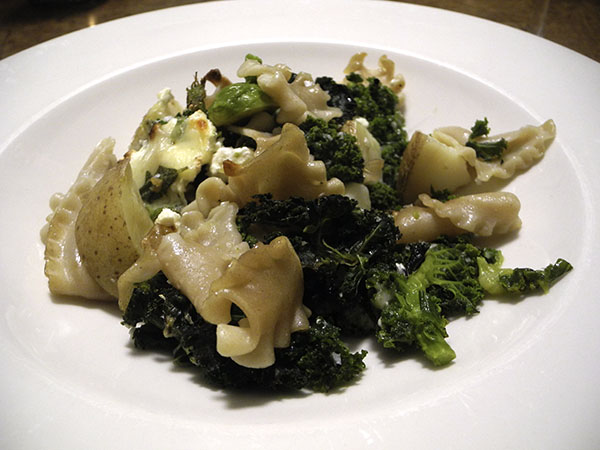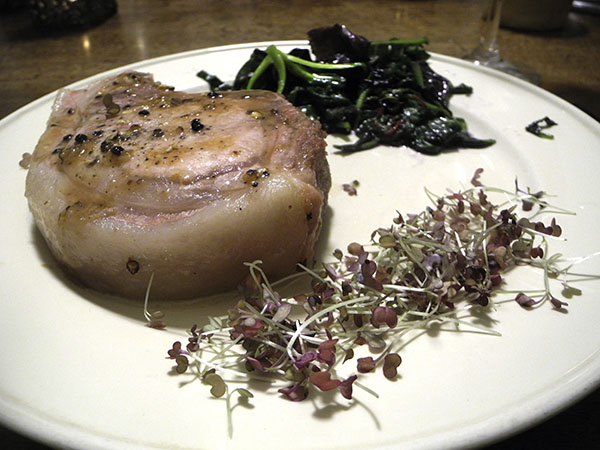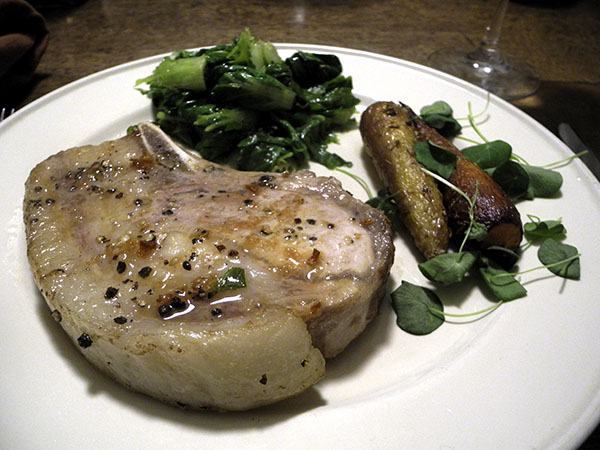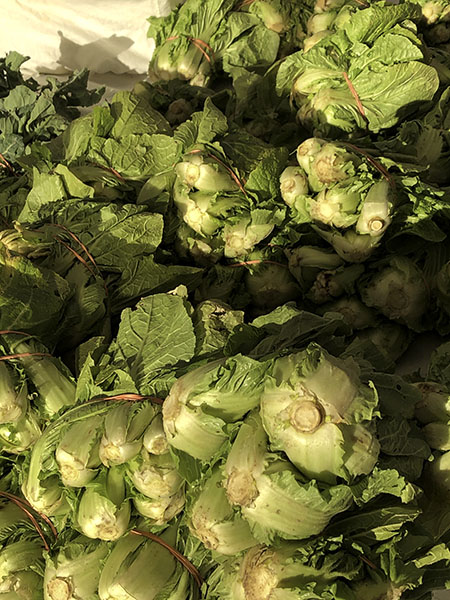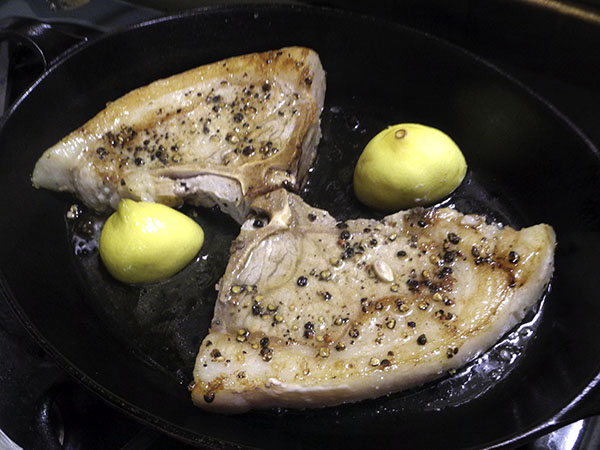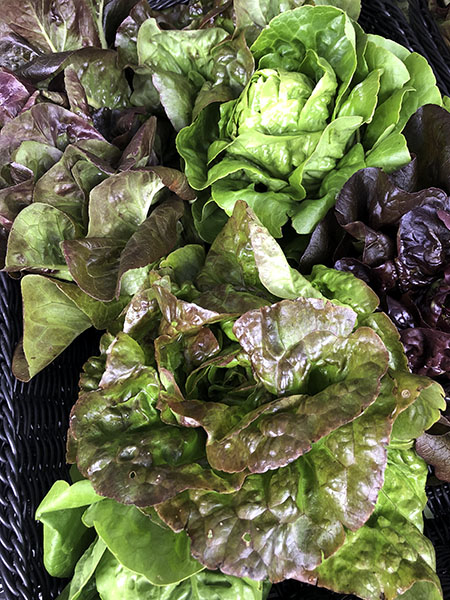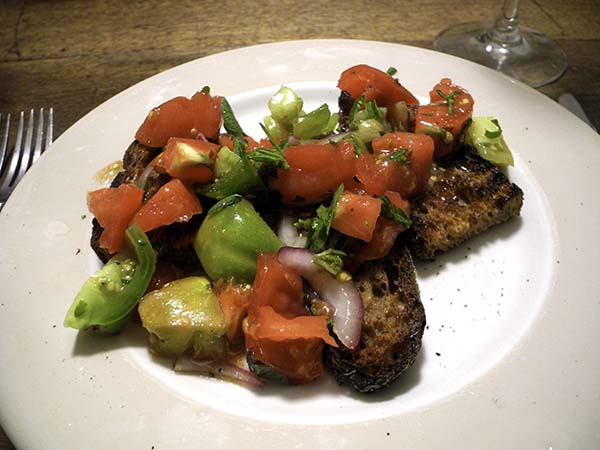
Although I hadn’t anticipated any problems earlier, once I had started to put it together, this meal turned out to be a bit of a challenge.
Without doing any research on it, I had decided to buy a vegetable (I think it’s actually a fruit) that I seen showing up in the Union Square Greenmarket for at least several seasons: Bitter melon [momordica charantia], known in India as Kerala, or elsewhere as bitter apple; bitter gourd; bitter squash; balsam-pear, or any number of other names, whose number suggests it’s more popular than most of us would imagine.
Before Sunday however I knew nothing about this gourd except that there were Chinese versions and Indian versions (on Friday I bought the shorter, more deeply green Indian one, with the much more rugged surface), and that both were very bitter. That description showed up everywhere, and otherwise I don’t remember any discussion of taste. I read only that it was bitter, very bitter; ‘an acquired taste’, the accounts all said, each adding that it might be something that could be acquired, if you were willing to keep at it).
I love cucumber, and I’m also used to sautéing it. While aware it was unlikely this particular beautiful gnarly green fruit, which also grows along a vine, would be anything like that favorite, my casual decision to associate it with cucumis sativus made it oh-so-easy to take home.
It wasn’t like cucumber, of course.
I have to make it clear that, for my own kitchen-conservative reasons (wanting it to relate to the style of, and to be incorporated into my own Western cooking, including the rest of the ingredients and recipes used in this particular meal), I chose to not prepare the melon in a manner even remotely related to customs in China or India, which may or may not explain why it was still so bitter when I served it, even though I followed the universal advice to soak the raw pieces in heavily salted water to reduce that attribute.
Supposedly it’s very good for you, and it appears in many forms, including extracts and capsules, that reflect the ancient Indian ayurveda tradition, but health foods and supplements are not a come-on that works for me; I’m more likely to be attracted to the rarity of something than its advertised wholesomeness.
I also had a couple of very ripe heirloom tomatoes on the windowsill, but before I had investigated the bitter melon cooking process very far it seemed to me that I had a lot of it, enough to make a second vegetable unnecessary.
I decided to use the tomatoes in a first course, but I didn’t have any form of soft cheese, which would be needed for what may currently be the most familiar way to use really good tomatoes. I did have a great bread, a very dark, complex bread, a corn and wheat bread, nutty, with a hint of sweetness, a kind that would be the rarity I mentioned above, at least in an Italian antipasto context – or in any kind of tomato first course – so I improvised a bruschetta.
Something else was unusual about the meal, although not as unusual as Indian Kerala, at least on our table. Instead of a grape wine, we enjoyed a wonderful bottle of a local dry cider! Think serious Basque dry cider.

- several heirloom tomatoes from Campo Rosso Farm, cut into 1/2-inch pieces, combined in a medium bowl with local Long Island sea salt from P.E. & D.D. Seafood, some freshly ground black pepper, one small sliced and chopped and red onion from Norwich Meadows Farm, a little While Foods Market house Portuguese olive oil, and some chopped epazote leaves from Jane’s TransGenerational Farm, spooned over several slices of wonderful dark Homadama bread (wheat, corn, water, maple syrup, salt, slaked lime) from Lost Bread Co.after their grill-marked toasted surfaces, immediately after coming off of a very hot cast iron ribbed grill pan, had been lightly rubbed with cut surfaces of a ‘Nootka rose’ garlic clove, also from TransGenerational Farm, served with more epazote sprinkled on top
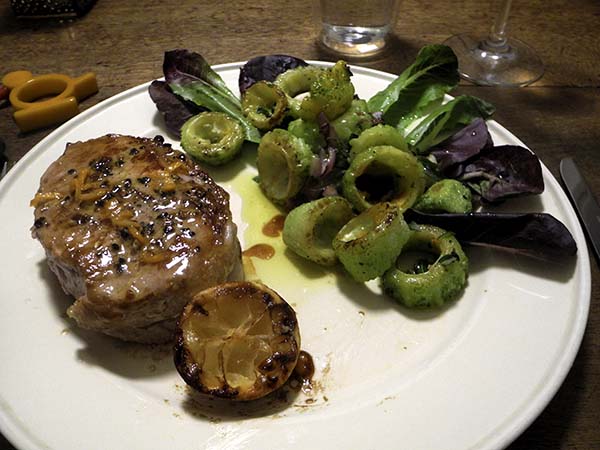
The main course followed soon after, because both the meat and the vegetable cooking times were short, and I was able to prepare most of the larger and smaller ingredients ahead of time.
Also, I was very interested to see how the vegetable would work out.
- two very thick 10-ounce boneless heritage breed pork chops from Raven & Boar farm, rinsed, dried thoroughly, seasoned on both sides with sea salt and freshly-ground black pepper, plus a very small amount of crushed hickory smoked Jamaican Scotch bonnet peppers from Eckerton Hill Farm, seared quickly in a heavy oval enameled cast-iron pan, one small halved Mexican organic lemon from Chelsea Whole Foods Market squeezed over the top of each (after which the lemon was left in the pan between them, cut side down), the chops placed inside a 400º oven for about 15 minutes altogether (flipped halfway through, the lemon halves squeezed over them once again and again on the bottom of the pan, some finely chopped fresh habanada chili from only a part of one pepper sprinkled on top of the pork at that time), removed from the oven and arranged on 2 plates, the few juices that remained poured over the top of each, the chops arranged on the plates accompanied by the lemon halves

- one pound of bitter melon from Gopal Farm, washed, cut into 2cm slices, the seeds and pith removed, placed inside a bowl, a generous amount of salt sprinkled on top and with enough water to just cover them, allowed to sit on the counter for about 20 minutes, removed, drained, and dried on a towel or paper toweling, placed inside a large heavy well-seasoned cast iron pan, sautéed over a medium-high flame, turning several times, sprinkled with sea salt after as they pieces had begun to carbonize, and, well into that process, one small sliced red one sliced small red onion from Norwich Meadows Farm added to the pan and the onions allowed to soften, some black pepper and a pinch of dried fenugreek from Bombay Emerald Chutney Company (purchased at the Saturday Chelsea Farmers Market) added, the mix arranged on the plates when done on top of fans of some leaves from a small head of purple Romaine lettuce from TransGenerational Farm, drizzled with both a little olive oil and a small amount of white balsamic vinegar, added part of the way into the meal, hoping it might mitigate the bitterness of the fruit (which is also why I had earlier added the lettuce, at the last moment)
So, the post-dinner report on the bitter melon? In the end it definitely remained bitter, but by the time I had finished I was thinking I may have already begun to ‘acquire the taste’ (Barry was somewhat less positive), but I’m still going to look further into the possibility of bringing down the acerbity.
- the wine was a New York (Hudson Valley) cider, Brooklyn Cider House Bone Dry cider, from the makers’ stand in the Union Square Greenmarket (it’s pretty awesome, and we’re definitely going stock up some more)
- the music was Henry Purcell’s 1692/1693 semi-opera, ‘The Fairy Queen’, performed by Sébastien D’Hérin conducting the ensemble, Les Nouveaux Caractères
